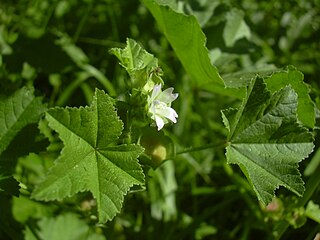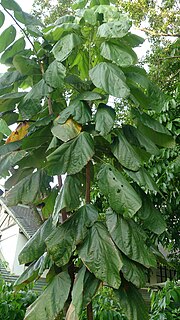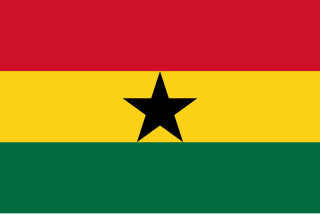
Sorghum is a genus of flowering plants in the grass family Poaceae. Seventeen of the 25 species are native to Australia, with the range of some extending to Africa, Asia, Mesoamerica, and certain islands in the Indian and Pacific Oceans. One species is grown for grain, while many others are used as fodder plants, either cultivated in warm climates worldwide or naturalized, in pasture lands. Sorghum is in the subfamily Panicoideae and the tribe Andropogoneae.

A bicolor cat or piebald cat is a cat with white fur combined with fur of some other color, for example black or tabby. There are various patterns of bicolor cat. These range from Turkish Van pattern through to solid color with a throat locket.

Malvaceae, or the mallows, is a family of flowering plants estimated to contain 244 genera with 4225 known species. Well-known members of economic importance include okra, cotton, cacao and durian. There are also some genera containing familiar ornamentals, such as Alcea (hollyhock), Malva (mallow) and Lavatera, as well as Tilia. The largest genera in terms of number of species include Hibiscus, Sterculia, Dombeya, Pavonia and Sida.

The swamp wallaby is a small macropod marsupial of eastern Australia. This wallaby is also commonly known as the black wallaby, with other names including black-tailed wallaby, fern wallaby, black pademelon, stinker, and black stinker on account of its characteristic swampy odour. The swamp wallaby is the only living member of the genus Wallabia.

Sorghum bicolor, commonly called sorghum and also known as great millet, durra, jowari, or milo, is a grass species cultivated for its grain, which is used for food for humans, animal feed, and ethanol production. Sorghum originated in Africa, and is now cultivated widely in tropical and subtropical regions. Sorghum is the world's fifth-most important cereal crop after rice, wheat, maize, and barley. S. bicolor is typically an annual, but some cultivars are perennial. It grows in clumps that may reach over 4 m high. The grain is small, ranging from 2 to 4 mm in diameter. Sweet sorghums are sorghum cultivars that are primarily grown for forage, syrup production, and ethanol; they are taller than those grown for grain.

The dark-backed weaver, also known as the forest weaver, is a species of bird in the Ploceidae family. It is found in Angola, Burundi, Cameroon, Republic of the Congo, Democratic Republic of the Congo, Equatorial Guinea, Gabon, Kenya, Malawi, Mozambique, Nigeria, Rwanda, Somalia, South Africa, South Sudan, Swaziland, Tanzania, Uganda, Zambia, and Zimbabwe.

The bicolored roundleaf bat is a species of bat in the family Hipposideridae found in Indonesia, Malaysia, the Philippines, Thailand, and Timor-Leste. This bat inhabits caves, rock crevices and tunnels among lowland forests. They roost in large numbers and consumer mostly small winged insects. Their navigation and hunting skills come from the use of echolocation. Its leafnose is used to release ultrasonic shouts to distinguish its surroundings. Echolocation is also used to distinguish other species based of their wingbeat and size. The habitat of this bat decides the color of its fur. Bleaching fumes of a cave environment will cause an orange colored fur. Those who inhabit a well-ventilated roost will be a light brown color.

Lupinus bicolor is a species of lupine known as the miniature lupine, Lindley's annual lupine, pigmy-leaved lupine, or bicolor lupine.

Xylococcus is a monotypic genus of flowering plants in the heath family which contains the single species Xylococcus bicolor, the mission manzanita.

Theobroma bicolor, known commonly as the Mocambo tree, jaguar tree, balamte, or pataxte, among various other common names, is a tree in the genus Theobroma, which also contains the better-known Theobroma cacao. It is known from Central and South America, including stretches of the Amazon rainforest in Brazil, Colombia, Ecuador, and Peru.
Listrocerum is a genus of longhorn beetles of the subfamily Lamiinae, containing the following species:
Listrocerum maynei is a species of beetle in the family Cerambycidae. It was described by Lepesme and Stephan von Breuning in 1956. It is known from the Democratic Republic of the Congo, Angola, Gabon, and the Central African Republic.
Listrocerum olseni is a species of beetle in the family Cerambycidae. It was described by Lepesme and Stephan von Breuning in 1956. It is known from Guinea.
Listrocerum quentini is a species of beetle in the family Cerambycidae. It was described by Lepesme and Stephan von Breuning in 1956. It is known from the Ivory Coast.
Listrocerum aeolis is a species of beetle in the family Cerambycidae. It was described by Thomson in 1857, originally under the genus Psathyrus. It is known from Mozambique, Ethiopia, Tanzania, Namibia, Kenya, Uganda, South Africa, and Zimbabwe.
Listrocerum apiceniger is a species of beetle in the family Cerambycidae. It was described by Stephan von Breuning in 1961. It is known from Cameroon.
Listrocerum aspericorne is a species of beetle in the family Cerambycidae. It was described by Chevrolat in 1855. It is known from Nigeria.
Listrocerum fuscopicalis is a species of beetle in the family Cerambycidae. It was described by Stephan von Breuning in 1961. It is known from Cameroon.
Listrocerum joveri is a species of beetle in the family Cerambycidae. It was described by Quentin in 1951, originally under the genus Combesius. It is known from the Ivory Coast.
Listrocerum murphyi is a species of beetle in the family Cerambycidae. It was described by Adlbauer in 2004. It is known from Malawi.












